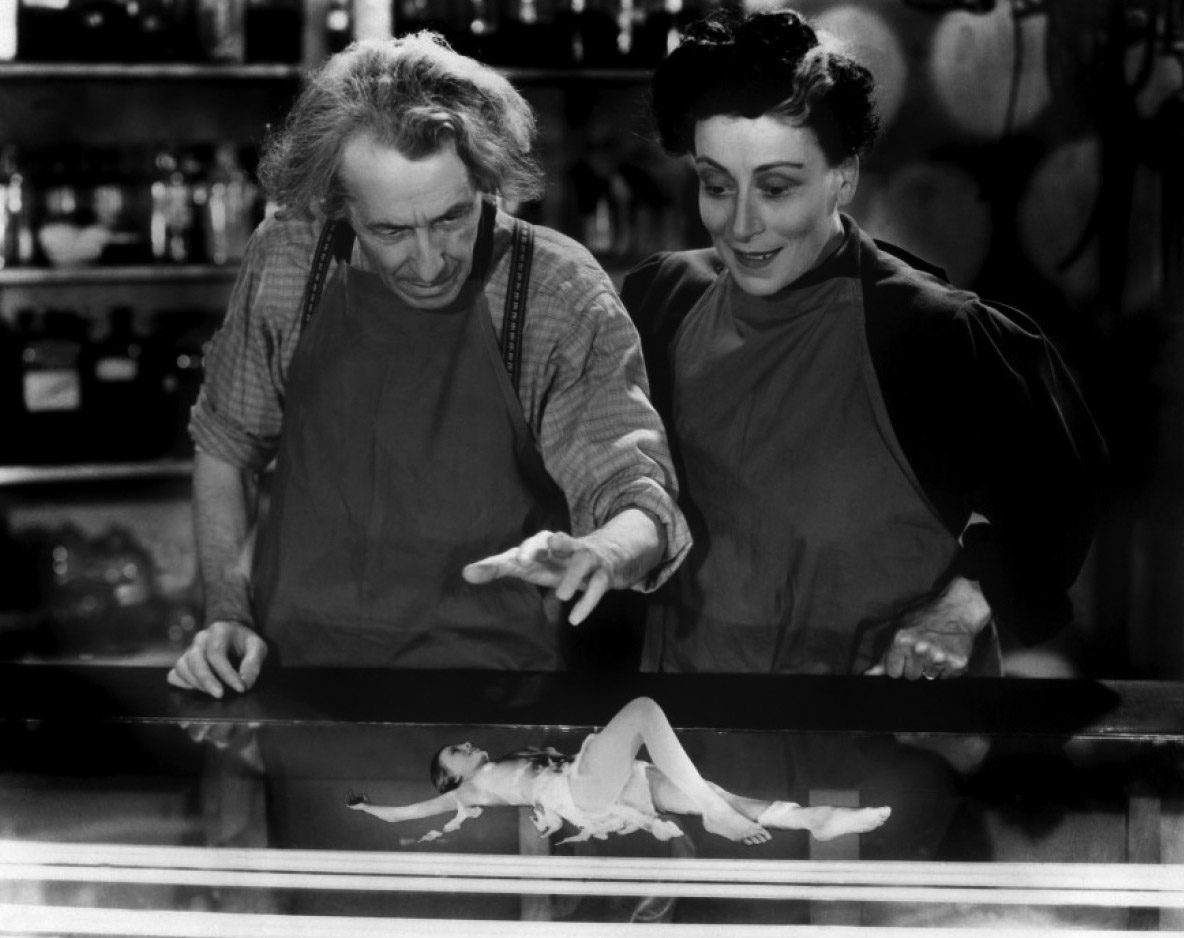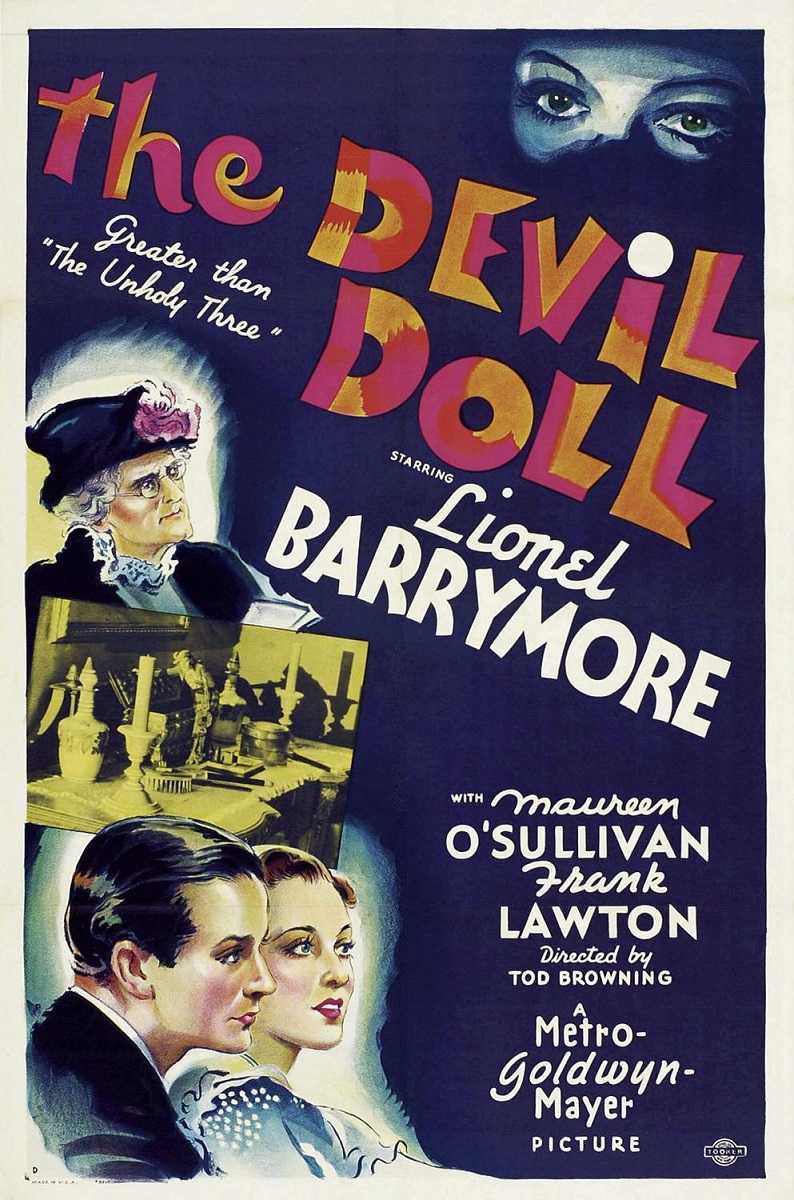Crew
Director/Story – Tod Browning, Screenplay – Guy Endore, Garrett Ford & Erich von Stroheim, Based on the Novel Burn Witch Burn (1932) by Abraham Merritt, Photography (b&w) – Leonard Smith, Music – Franz Waxman, Art Direction – Cedric Gibbons. Production Company – MGM.
Cast
Lionel Barrymore (Paul Lavond), Maureen O’Sullivan (Lorraine Lavond), Raffaela Ottiano (Malita), Frank Lawton (Toto), Henry B. Walthall (Marcel), Robert Greig (Emil Coulvet), Grace Ford (Lackno), Pedro de Cordoba (Charles Matin), Arthur Hohl (Rodin)
Plot
Banker Paul Lavond makes an escape from Devil’s Island where he was sentenced for seventeen years after being framed by his three partners. His fellow escapee Marcel takes him to meet his wife Malita. As Lavond watches, Marcel demonstrates a process whereby he can shrink animals and people to the size of dolls and animate them by will power. Marcel then has a heart-attack and dies. Malita persuades Lavond to continue his work and Lavond sees the opportunity to have revenge on those that framed him. Disguising himself as an old woman, Madame Mandelip, he and Malita set up a doll shop in Paris where Lavond then sends the shrunken people out to kill his enemies.
The Devil-Doll is one of the celebrated classics of the Golden Age of Horror. It came from the great Tod Browning, who had made his name during the silent era with such films as The Unholy Three (1925), London After Midnight (1927), The Unknown (1927) and West of Zanzibar (1928), before making the move over into sound with the Bela Lugosi Dracula (1931), Freaks (1932) and Mark of the Vampire (1935). The Devil-Doll was Tod Browning’s second-to-last film.
Tod Browning’s great collaborator of the silent era was Lon Chaney [Sr]. Chaney always gave grand performances where he would undergo amazing physical transformations and complete character shifts. These performances were always at the centre of Tod Browning’s silent films. However, Chaney died in 1930 and afterwards Browning seemed to lack such a collaborator. He did luck upon Bela Lugosi in Dracula. In The Devil-Doll, he used Lionel Barrymore, one of the great Broadway actors of the decade. Lionel Barrymore gives Tod Browning the nearest to another Chaney performance that he would ever find again, wherein he undergoes a great chameleon shift in playing the part of an old woman.
Outside of Lionel Barrymore though, the story of The Devil-Doll is slight and melodramatic (as was often the case with Tod Browning’s films). The other notable aspect is the effects set-pieces. The effects are variable but at least Browning sets up some good set-pieces with the miniature people climbing onto dressers to steal jewelry and up a sleeping person’s peignoir to kill them.

The Devil-Doll is often reviewed as a science-fiction film. In truth though, Tod Browning has almost no interest in science-fiction (even less than other mad scientist films from the era). If The Devil-Doll is a mad scientist film, it is one based more in alchemy than it is in science. Coulter’s grand claim that “we can shrink the world” on the theory that it will eliminate hunger is absurd. (One is not even sure if he means shrinking just people or all animal species. Reducing all animal species simply reduces the size not the ratio of humans to animal species; reducing all people would surely turn everybody into the prey of now giant-sized animals). Certainly, Lionel Barrymore’s character is portrayed a good deal more sympathetically than any other mad scientist of the era.
The Devil-Doll was adapted from a novel by Abraham Merritt, a popular writer of dark fantasy during the 1920s, with works such as The Moon Pool (1919), The Metal Monster (1920), The Ship of Ishtar (1926) and Seven Footprints to Satan (1928), which was also filmed as Seven Footprints to Satan (1929). The film is liberally adapted from Merritt’s witchcraft novel Burn, Witch, Burn (1933).
The Devil-Doll should not be confused with the later British horror film Devil Doll (1964) about a sinister hypnotist.


